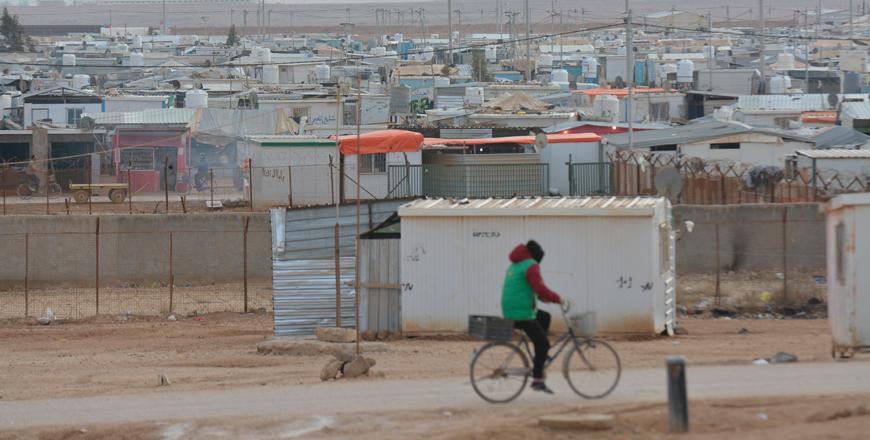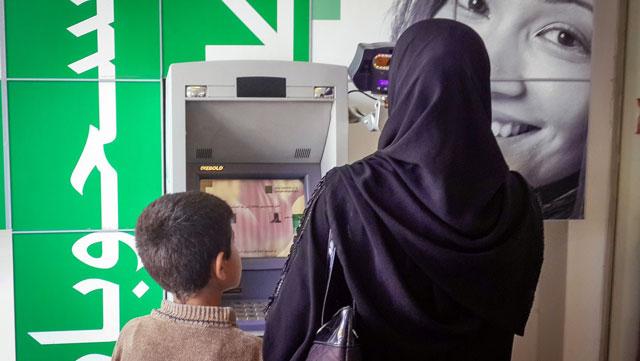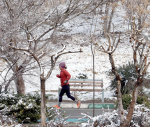You are here
Kingdom’s two solar-powered Syrian camps look to balance growing electricity demand
By Lucie Lagodich - Jul 05,2022 - Last updated at Jul 05,2022

Syrian refugees are seen in the Azraq camp around 100km from Amman, in the Eastern Desert (Photo by Hanna Davis)
AMMAN — The introduction of solar plants at Jordan’s two-largest Syrian refugee camps, Azraq and Zaatari, have brightened the homes of 100,000 refugees.
In 2017, Azraq became is the world’s first refugee camp to be powered by solar energy, Zaatari camp following close behind, according to a UNHCR statement.
An initiative in line with Jordan’s sustainable development plans, the Zaatari plant has reduced pollution by 15,600 tonnes of CO2 per year and the plant at Azraq camp by 6,300 tonnes of CO2 per year, Maher Maymoun, an electrical engineer at UNHCR Jordan, told The Jordan Times.
Hatem Al Balkhe, a senior assistant electrical engineer and Syrian refugee residing at Azraq camp, said that the solar plant has an electrical capacity of five megawatts.
Balkhe lived at the camp for two years before electricity was provided and described it as “very isolated”.
“Imagine life without electricity, without a fan, without a fridge, without being able to charge your phone. It felt like we were more isolated from the world itself. We couldn’t even open our phones and check the news or open the TV and hear what’s happening in the world,” Balkhe told The Jordan Times.
He said that prior to the introduction of the solar plant there were no streetlights or opportunities to socialise after dark.
“You had to stay in the caravan and sleep. It goes beyond that as well and makes it safer for women and children to move around after the sunset,” Balkhe said.
There was also no way to refrigerate medicine or food, leading to high amounts of food waste, he said, adding that individuals who needed electric-powered medical equipment struggled.
Balkhe said there was an “immediate shift” when the solar plant became operational, many of the aforementioned issues “suddenly gone”.
“Life changed from being a completely from dark to light,” Balkhe added.
The solar plant also created job opportunities for refugees in the camp, many of whom have backgrounds as electrical engineers in Syria, UNHCR Communications Officer Lilly Carlisle said.
Electricity challenges
According to Carlisle, electricity is provided 11 hours a day to camp residents and around 80 per cent of the needs in the camp are met during this period.
However, due to spikes in energy demand and the subsequent electric bills during the summer months, last week electricity access was reduced to nine hours a day at both camps, according to Hamzeh Almomani, a UNHCR assistant external relation officer.
Streetlights and markets still have 24-hour electricity access to meet the safety and food needs at the camps, Almomani noted.
Maymoun said with a continuing growth in consumption and the fixed amount of solar generation, the energy needs are getting bigger.
“The gap is being paid by UNHCR so now we’re looking into innovations, how to maintain a fair distribution of energy between all shelters while maintaining a reduced carbon footprint,” he said.
The UNHCR is focused on investing in sustainable solutions for energy demand, as expanding the solar fields are expensive and require unsustainable resources, according to Maymoun.
“It’s not good for the environment. So, the best and the greenest energy source is energy efficiency. This reduces the demand and makes energy consumption much more efficient at the camp level and even at the camp offices,” Maymoun said.
There are a few pilot projects underway at both camps to encourage sustainable energy usage among residents, such as installing LED street lighting. Another project currently under way is called Equitable Energy for Refugees (EER), a device attached to a shelter limits daily energy use, Maymoun added.
“EER will raise the energy awareness for the shelters, because if you have free uncontrollable energy, nobody will care about energy management. But if you give them a certain amount a limit of energy that they consume daily, this will raise awareness and raise the responsibility for the households and refugees, how to manage that amount of energy,” Maymoun said.
Maymoun noted that the camps are “the centre of innovation and green energy”, and they hope to have 100 per cent of energy provided by solar energy in the future.
Related Articles
AMMAN — Approximately 12,000 refugee families are on the cash assistance waitlist, meaning that they are eligible but unable to receive mont
AMMAN — Thousands of Syrian refugees will be able to light their homes, charge their phones and chill their food by solar power as Jor
AMMAN — An average of 30,000 vulnerable refugee families benefit each month from assistance in form of a social (cash) transfer to cover the


















